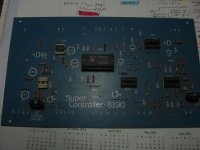I recently aquired an analog synthesizer module. It is called Super controller 8190. I have the shematics. The ICs are vaguely identified. Could someone please help to identify these? I am uploading schematics.
The lower right saysZ:
Power supply connections to op-amps assumed. A2, A8, A9 mustbe bi-fet op-amps, all others are 741 type op-amps.
Written in ink is IC2 at A1, IC3 at A2, IC4 at A3, IC4 at A4, IC4 at A4, IC4 at A5, IC4 at A6, IC3 at A7, IC3 at A7, IC3 at A8, IC3 at A9, IC2 at A10. I am not certain the handwriting is correct.
The lower right saysZ:
Power supply connections to op-amps assumed. A2, A8, A9 mustbe bi-fet op-amps, all others are 741 type op-amps.
Written in ink is IC2 at A1, IC3 at A2, IC4 at A3, IC4 at A4, IC4 at A4, IC4 at A5, IC4 at A6, IC3 at A7, IC3 at A7, IC3 at A8, IC3 at A9, IC2 at A10. I am not certain the handwriting is correct.
Attachments
I just betcha that the opamps are 324/358 or no better... A favorite practice of early game board manufacturers was to get special TTL parts with different part numbers than the actual part numbers used in the boards (but real TTL part #s), so that obvious copiers would slavishly order the phony part #s and go down in flames...
The SN76477 was developed by Texas Instruments in the late 70s for sound generation in toys and video games. this link gives a good overview.
Texas Instruments SN76477 - Wikipedia, the free encyclopedia
The bifet opamps could be from the TL07x or TL08x family also from Texas Instruments.
If you need replacement parts, the opamps should still be available but you may find the sound generator a bit of a challenge. I have a couple on hand if you are desperate.
Texas Instruments SN76477 - Wikipedia, the free encyclopedia
The bifet opamps could be from the TL07x or TL08x family also from Texas Instruments.
If you need replacement parts, the opamps should still be available but you may find the sound generator a bit of a challenge. I have a couple on hand if you are desperate.
Here's my guess at an original parts list:
IC1 = SN76477 sound generator
IC2 = 741 op amp
IC3 = CA3140 BiFET op amp
IC4 = 741 op amp
IC5 = NE555 timer
IC6 = CD4001 quad NOR gate
IC1 = SN76477 sound generator
IC2 = 741 op amp
IC3 = CA3140 BiFET op amp
IC4 = 741 op amp
IC5 = NE555 timer
IC6 = CD4001 quad NOR gate
Now I am getting excited! Thanks for the toy sound generator heads up! Thank God those waveforms are for modulation and control!
Most info from the note in the lower right corner of the schematic:
IC1 = already there
IC2 = dual "741" such as LM747
IC3 = quad "bifet" such as TL084, AD713, LF347, etc.
IC4 = quad "741 such as LM348, RC4136, etc.
IC5 = already there
IC6 = CMOS quad 2 input nor gate such as CD4001 or 74HC02
Except for the places where there is heavy loading (such as using an op amp to drive the flashing LED for LF clock), you could use a TL084 (quad) and TL082 (dual) for all op amps - they are cheap and easy to get. Actually, I'd try anyways (we are not trying to clone a Mini-Moog or something like that) and it will probably be fine for this circuit 🙂
But I wonder why the silk screen outline for Q6 is different from the other JFETs?
mlloyd1
IC1 = already there
IC2 = dual "741" such as LM747
IC3 = quad "bifet" such as TL084, AD713, LF347, etc.
IC4 = quad "741 such as LM348, RC4136, etc.
IC5 = already there
IC6 = CMOS quad 2 input nor gate such as CD4001 or 74HC02
Except for the places where there is heavy loading (such as using an op amp to drive the flashing LED for LF clock), you could use a TL084 (quad) and TL082 (dual) for all op amps - they are cheap and easy to get. Actually, I'd try anyways (we are not trying to clone a Mini-Moog or something like that) and it will probably be fine for this circuit 🙂
But I wonder why the silk screen outline for Q6 is different from the other JFETs?
mlloyd1
- Status
- Not open for further replies.
